Tom Phillips, Department of Agriculture, Maryland, USA; Waterford, Inc., Milford, MA, USA
Tom DePhillipo, Jeff Wright, Rui Chen
Application Advantages â– Supercritical fluid extraction can be used as an alternative to the use of Rapid Solvent Extraction (ASE) to analyze fat content.
â– Use software-controlled extraction processes for greater accuracy and precision in fat extraction and subsequent analysis.
â– Supercritical fluid extraction based methods can eliminate the hydrolysis steps associated with fat analysis.
â– It has a positive impact on the sustainability of the environment and can result in significant cost savings.
Waters Solutions
MV-10 ASFE System ChromScopeTM Software
Key words <br>fat, animal feed, supercritical fluid extraction, fast solvent extraction
Introduction <br> Fat content is an important nutritional and quality control parameter in the production of animal feed. Therefore, process optimization requires a fast and reliable method of measurement. Various solvent extraction methods—including cable extraction and rapid solvent extraction (ASE), and subsequent gravity analysis, are often used for the analysis of fat content. Solvents frequently used in these extraction methods include n-hexane and diethyl ether.
As people's awareness of environmental sustainability increases, supercritical fluid extraction (SFE) has been used to remove fat from various matrices. The low polarity of supercritical carbon dioxide (SC-CO 2 ) is an ideal solvent for fats 1-2 . In addition, the adjustment of the dissolving power is achieved by changing the pressure and temperature and/or adding an organic solvent to change the desired selectivity. Other advantages of supercritical fluid extraction include: carbon dioxide is relatively less toxic, non-flammable and inexpensive; extracts are easy to recycle; solvent consumption and throughput are reduced.
In this application note, we performed a performance evaluation of the Waters MV-10 ASFETM system for extracting fat from various animal feed products, and the results of the evaluation were compared with the results using the fast solvent extraction method. Compared. At the same time, the prospect of conventional fat analysis using supercritical fluid extraction was discussed.
experiment
Sample Description <br> Unless otherwise stated, various commercially available animal feeds are used in accordance with the feed received and are not otherwise disposed of.
Method Conditions <br>Supercritical Fluid Extraction (SFE) Conditions For each supercritical fluid extraction experiment, approximately 3 g of ground comminuted animal feed was added to a 5 mL extraction vessel. The extracted fat is collected into a pre-weighed scintillation vial. After removing the solvent in the extract using a Zymark Turbovap LV vaporizer, the weight of the scintillation vial was reweighed. The difference in weight is considered to be the amount of fat in the sample.
Temperature: 40 °C
Pressure: 3625 psi
Cosolvent: Methanol cosolvent (%): 10%
Flow rate: 8 mL/min
Software: ChromScope
Total running time: 25 min
Conditions for rapid solvent extraction <br> For each rapid solvent extraction experiment, approximately 3 g of ground comminuted animal feed was added to a 10 mL extraction vessel. The extracted fat is collected into a pre-weighed collection bottle. After removing the solvent in the extract using a Zymark Turbovap LV type evaporator, the weight of the collection bottle was reweighed. The difference in weight is considered to be the amount of fat in the sample.
Temperature: 125 °C
Pressure: 1000 psi
Extraction solvent: Preheating time of n-hexane extraction furnace: 5 min
Extraction furnace preheating cycle number: 2
Static time: 3 min
Number of static cycles: 2
Washing volume: 60%
Purge time: 1 min
Number of purge cycles: 2
Total running time: 18 min
Results and discussion
Comparison of Supercritical Fluid Extraction and Rapid Solvent Extraction <br> Table 1 summarizes the results of fat analysis for 15 animal feed products. In order to evaluate the general applicability of supercritical fluid extraction in fat analysis, we have deliberately selected samples to ensure the diversity of the samples in product form and in the animals. It is also worth noting that Sample 8 and Sample 9 were hydrolyzed prior to rapid solvent extraction. In the accelerated solvent extraction method, it is common practice to add a hydrolysis step prior to extraction to decompose the sample in order to destroy the cell wall and release the fat.
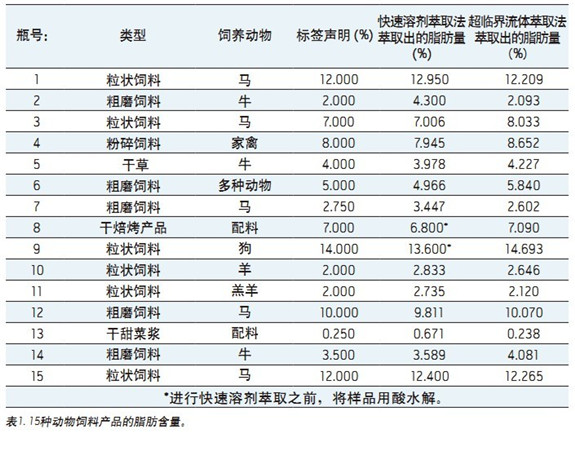
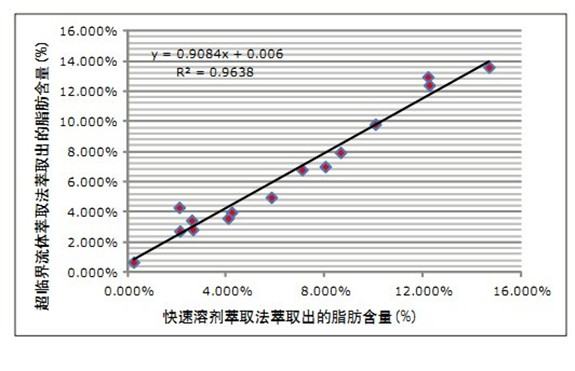
Figure 1 shows the relationship between the fat content obtained by supercritical fluid extraction and rapid solvent extraction. It is obvious that the two extraction methods are identical. The results indicate that supercritical fluid extraction is a potential alternative to rapid solvent extraction in fat analysis.
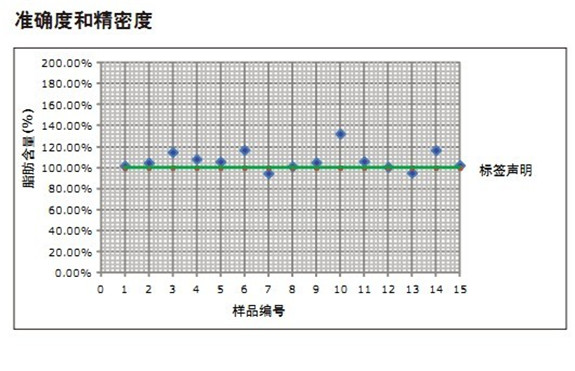
Fig. 2 is a distribution of fat content (%) obtained by supercritical fluid extraction. The fat content (%) ranged from 95% to 132%, and the fat content of most samples (11/15 samples) ranged from 95% to 110%, indicating that the fat content is in full compliance with the label statement.
Table 2 summarizes data for reproducibility studies of fat analysis based on supercritical fluid extraction. The relative standard deviation % (RSD%) of the five parallel experiments was less than 2%. The MV-10 ASFE system is controlled by ChromScope software. After the sample is added to the extractor, the extraction process requires no user intervention, thus ensuring high precision for subsequent analysis.
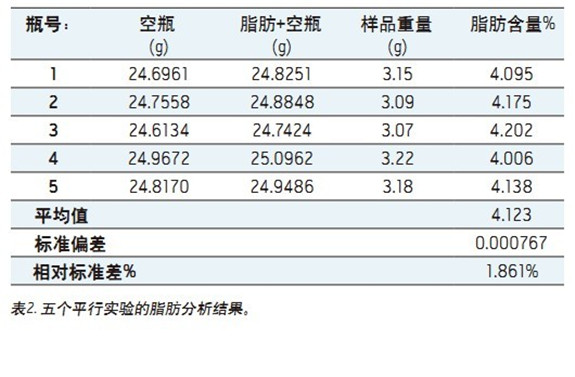
Conclusions <br>In this application note, we show that supercritical fluid extraction can replace the rapid solvent extraction method used in the industry and is used to determine the fat content of animal feed. The accuracy and precision of the entire analysis is achieved using a software controlled extraction process. The method based on supercritical fluid extraction also eliminates the hydrolysis step, which is an essential step in other extraction methods. Finally, in addition to the positive impact on environmental sustainability, supercritical fluid extraction uses methanol compared to n-hexane used in rapid solvent extraction, which can result in significant cost savings.
references
1. Taylor SL, King JW, List GR. Determination of oil content in oilseeds by analytical supercritical fluid extraction. J Am Oil Chem Soc. 1993 Apr; 70(4): 437-9. 2. King JW, Eller FJ, Snyder JM, Johnson JH, McKeith FK, Stites CR. Extraction of fat from ground beef for nutrient analysis using analytical supercritical fluid extraction. J Agric Food Chem. 1996 Sept; 44:2700-4.
For cardio-pulmonary resuscitation and general respiratory asphyxia patients needing emergency care. When the accident occurs, especially difficulty in breathing or the need to improve patient use of supplementary oxygen. Portable resuscitator, the first time in first aid and emergency use, you can quickly oxygen or unconscious persons CPR-BLS (the primary life-support) to facilitate the ready to immediately put into use, greatly increased hope of survival.
Feature:
It is semi-transparent and comes with a pressure limitation valve for patient safety
A textured surface ensuring a firm grip and providing effective ventilation.
Patient connector is 22/15mm.
100% latex free.
It is made of medical grade PVC/Silicone
Three sizes are available, suitale for adult, child and infant.
The accessories includes anesthesia mask(1),oxygen tubing(1),reservoir bag(1),opener(1) and airways(3).
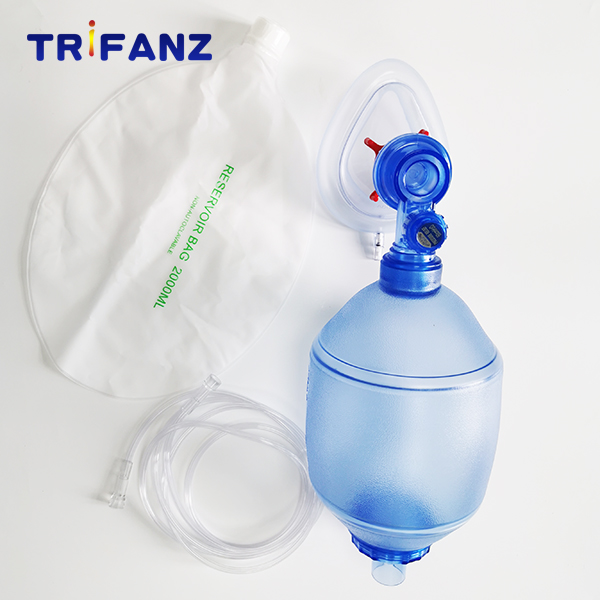
Pvc Manual Resuscitator,Potable Resuscitator,Manual Ventilator Bag,Adult Manual Resuscitator
Hangzhou Trifanz Medical Device Co., Ltd , https://www.cfzmeds.com